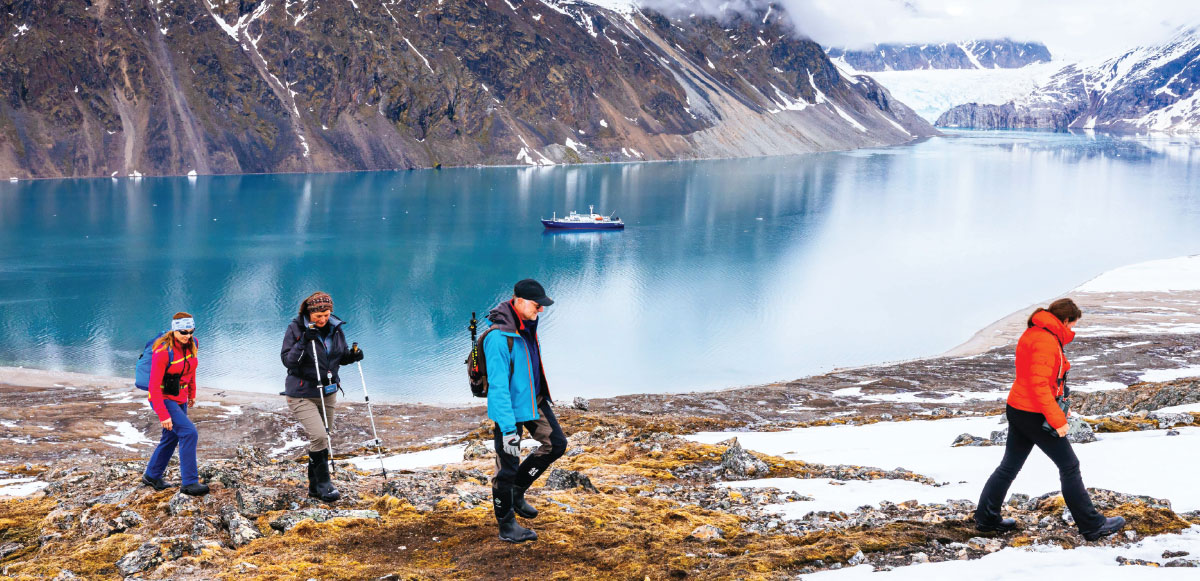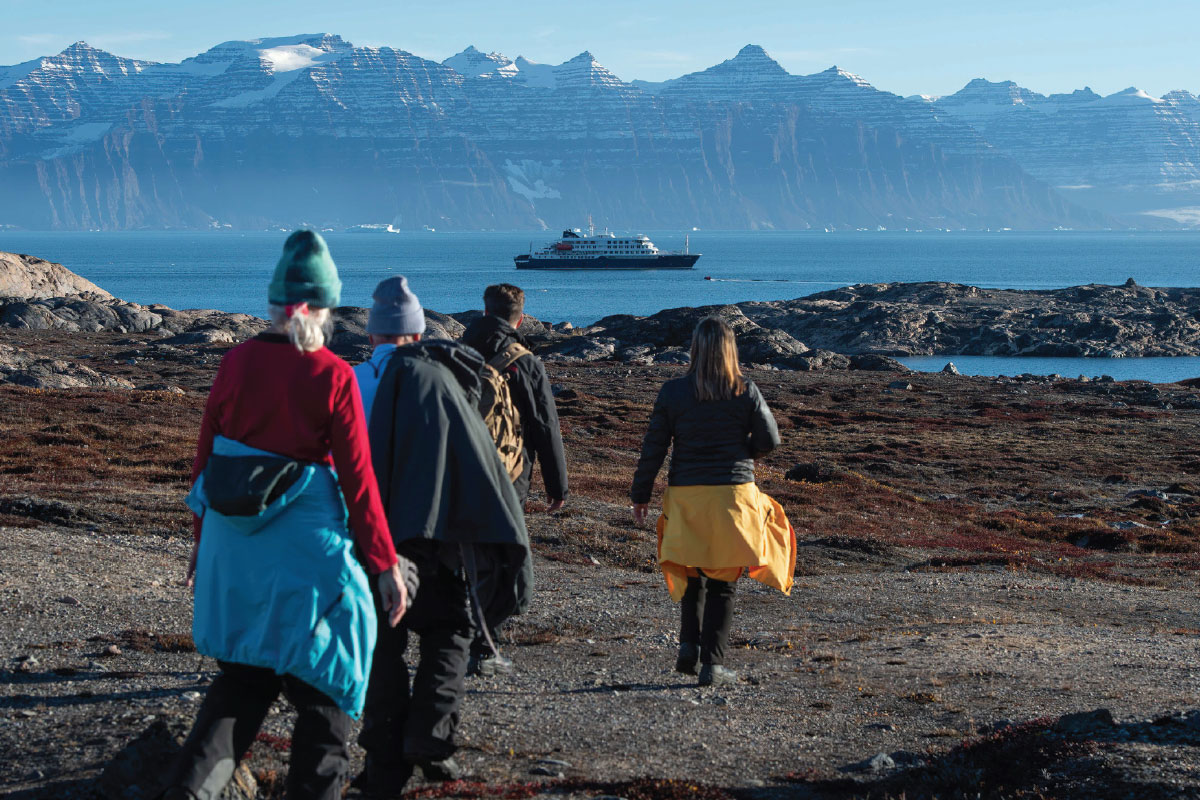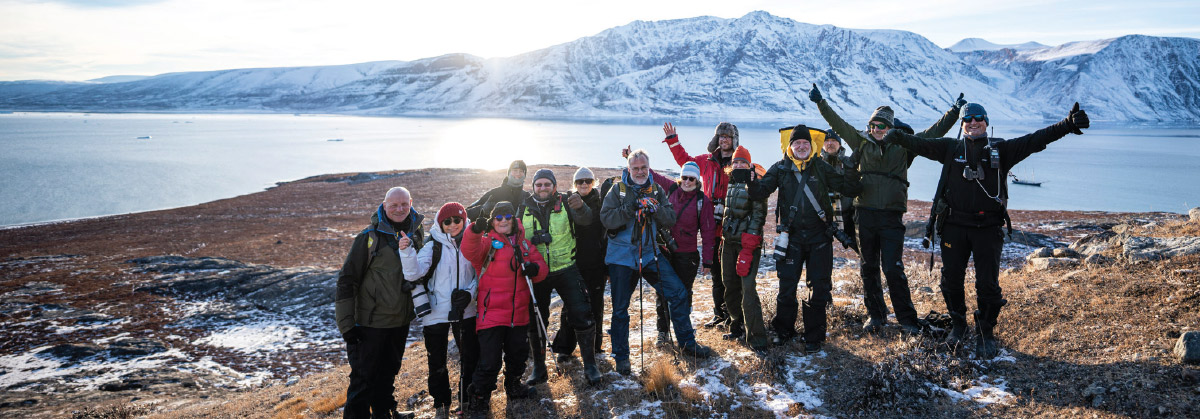Cruising
laska sits atop many travelers’ bucket lists, and most fulfill their dream of visiting the 49th state with a cruise. A 2024 McKinley Research Group study prepared for the Alaska Travel Industry Association found that 2.6 million people visited Alaska during the 2023 summer travel season, and two-thirds of them, or 1.7 million, arrived via cruise ship. Juneau, Ketchikan, and Skagway were the top ports of call, with each of the Southeast cities welcoming 70 percent or more of that year’s cruise visitors.
In recent years, cruise ship aficionados and travelers looking to explore some of the world’s most remote regions have begun boarding ships that chart a course farther north, beyond the Arctic Circle. They venture into an area that encompasses the northernmost parts of Alaska, Canada, Scandinavia, Greenland, Russia, and Iceland.
“Interest in polar regions, particularly the Arctic, has grown over the past thirty years,” says Florian Piper, director of Arctic program sales for Oceanwide Expeditions, a Netherlands-based company that has offered polar expeditions to the Arctic and Antarctica for thirty years. “While the region has long attracted birders and those looking for unparalleled adventure, its popularity has recently expanded to include a diverse range of travelers, including families, solo travelers, and those drawn to remote and untouched destinations like the Arctic.”
According to the Arctic Council, an intergovernmental forum promoting cooperation in the Arctic, in 2022 passenger cruise ships comprised just 5 percent of all vessels entering the Arctic Polar Code region, which sits at latitude 66.5° north of the equator. Though passenger ships are a small portion of vessels entering the region, their numbers have increased over the past decade. Data from Straits Research shows a 37 percent increase in passenger ship travel to the Arctic from 2013 to 2020, and 32,356 visitors to the region in 2019. In 2022, seventy-eight cruise ships made 250 trips to the region.
Cruise companies are meeting the demand by expanding their tour offerings.
“We continue to enhance our Arctic cruises to offer our guests unique experiences through the natural beauty; stunning landscapes; wildlife, birdlife, and marine life; and unique geography of the Arctic,” says a spokesperson for Silversea Cruises, which was founded in 1994 and sailed to Svalbard, Iceland, and Greenland for the first time in 2008. “We recently announced 230 new voyages for 2026–2027, which will… feature 131 expedition voyages to some of the world’s most remote regions—such as the Arctic, Antarctica, Galápagos [Islands], and more.”
Arctic cruises come with a hefty price tag—$10,000 to $20,000 per person or more, says Scott McMurren, publisher of the Alaska Travelgram newsletter—but for those with the financial means, they promise travelers a thrilling once-in-a-lifetime adventure.
Andrew Peacock | Oceanwide Expeditions

More than a century later, melting ice has made navigating the region easier; over the past thirty years, the oldest and thickest Arctic ice has decreased 95 percent. The easier travel is especially true of the Northwest Passage, which stretches 1,700 nautical miles from Canada’s Baffin Island to the Beaufort Sea. In the 1980s the navigable period for open water vessels through the Northwest Passage was sporadic; starting in the 2010s, it grew to approximately ninety-two days per year.
Lindblad Expeditions in 1984 became the first cruise company to take a passenger ship through the Northwest Passage. In 2016, Crystal Serenity was the first large luxury cruise ship to make the trip, starting in Anchorage and making a stop in Nome before traveling east through the passage on its way to New York.
Cruise ship companies continue to take advantage of that ever-growing ease by modifying and increasing their fleet to ensure vessels have the capability to safely and responsibly navigate the icy waters while complying with regulations for traveling through the region. The International Code for Ships Operating in Polar Waters, which the International Maritime Organization adopted in 2014, dictates equipment, operations, and design and construction requirements for polar vessels. Requirements vary depending on the ship category, which is dictated by the type of waters ships travel through: Class A for medium first-year ice, Class B for thin first-year ice, or less than Class A or B for ships traveling into open water or light ice.

Koen Hoekemeijer | Oceanwide Expeditions
A team of onboard experts—guides, naturalists, and scientists—host lectures and discussions, help guide the itinerary, and lead off-boat excursions in small, inflatable boats that can give passengers an even more intimate look at the communities, wildlife, and landscapes.
“On- and off-board activities are designed to bring our customers closer to nature,” Piper says. “So that means rather than lounging by the pool, they might find themselves kayaking, polar diving, hiking, or snowshoeing.”
McMurren says feedback he has received from people who’ve taken expedition cruises says the on-board education is a highlight of the trip.
“[They] talk about how cool it is to have world-class scientists on board to explain the unique qualities of the landscape outside,” he says. “That includes anthropologists to discuss Indigenous populations, geologists to dissect the physical environment, and naturalists to provide insight on the animals in the neighborhood.”
Inherent in any Arctic cruise is flexibility. Weather or ice conditions or the opportunity to view wildlife may require sudden detours or slow a ship down. That uncertainty is part of the allure.
“This is the unpredictable nature of expedition travel,” Piper says. “Every voyage is an unknown adventure, which is exactly what makes every voyage with us unique.”
Visitors are drawn to the region’s towering glaciers, stunning fjords, snow-covered tundra, and floating sheets of ice; and wildlife such as polar bears, Arctic foxes, walruses, Arctic wolves, musk ox, and narwhals; and the ability to experience 24 hours of sunlight.
As the Northwest Passage becomes more navigable, the number of cruises through the region is growing. From 2013 to 2019, there was a 44 percent increase in the number of ships traveling the passage, according to Straits Research. Even some large liners that don’t make the Northwest Passage voyage have begun offering extended Alaska cruises that give travelers a taste of the Arctic, even if not on the same scale as smaller ships.
The largest of these is Holland America Line’s 1,916-passenger Westerdam, which departs Seattle on a twenty-eight-day Alaska Arctic Circle Solstice Tour. First offered in 2024, the cruise includes the typical Inside Passage stops but continues north to Nome with a day spent across the Arctic Circle. While in Nome, passengers can explore the town’s Gold Rush history, take guided hikes with locals, and attend an Alaska Native Culture Camp. Nome’s “limited tourism infrastructure” is billed as part of its charm, for now, and passengers are told they’ll be “trading breadth of experience for authentic interaction.”
Jacques Marais | Oceanwide Expeditions

HX offers the nearly identical trip in reverse, the twenty-six-day Northwest Passage—Across the Top of the World aboard the 490 passenger MS Roald Amundsen. Passengers fly from Seattle to Nome, board the ship there, and travel east through the Northwest Passage before a final stop in Greenland. HX also offers several other Alaska cruises that travel from Vancouver, British Columbia to Nome (or Nome to Vancouver) through the Inside Passage, the Gulf of Alaska, and the Aleutians.
National Geographic-Lindblad Expeditions’ sixty-nine-day Epic Northwest Passage: Iceland to Japan cruise also travels through Greenland, the Canadian High Arctic, and the Northwest Passage, making a stop in Nome on its way south to Japan. Two shorter cruises through the Northwest Passage offer a twenty-three-day adventure, with the option to travel from Nuuk, Greenland to Nome or from Nome to Greenland.
Other tours originating in Greenland include Aurora Expeditions’ twenty-nine-day Traversing the Northwest Passage aboard the 130 passenger ship Sylvia Earle, which spends four days cruising the Beaufort and Chukchi Sea and the Bering Strait before disembarking in Nome; Hapag Lloyd Cruise’s twenty-nine day voyage aboard the Hanseatic Spirit, which travels through the Northwest Passage and Beaufort Sea and makes a stop in Nome before heading to its final destination in Seward; and Silversea’s twenty-three-day cruise aboard its luxury expedition ship Silver Endeavour, which includes a stop in Point Hope, where passengers can explore the village of about 800 people with a resident guide or do a guided expedition tour with ship crew, before disembarking in Nome.
The French cruise company Ponant’s first high-luxury polar expedition vessel, Le Commandant Charcot, takes passengers on a twenty-one-day cruise package named Transarctic, the Quest for the Two North Poles. The trip attempts the transpolar maritime route from Svalbard to Nome to reach the magnetic and geographic North Poles.
As access to the Arctic continues to rise, cruise lines remain ready to meet that demand and improve their offerings. According to Silversea, “We continue to enhance our Arctic cruises to offer our guests unique experiences through the natural beauty, stunning landscapes, wildlife, birdlife and marine life, and unique geography of the Arctic.”
And the growing interest in Arctic travel makes sense, particularly for the well-traveled, Piper says. “For those who have traveled the world, the Arctic is the next best place to visit.”